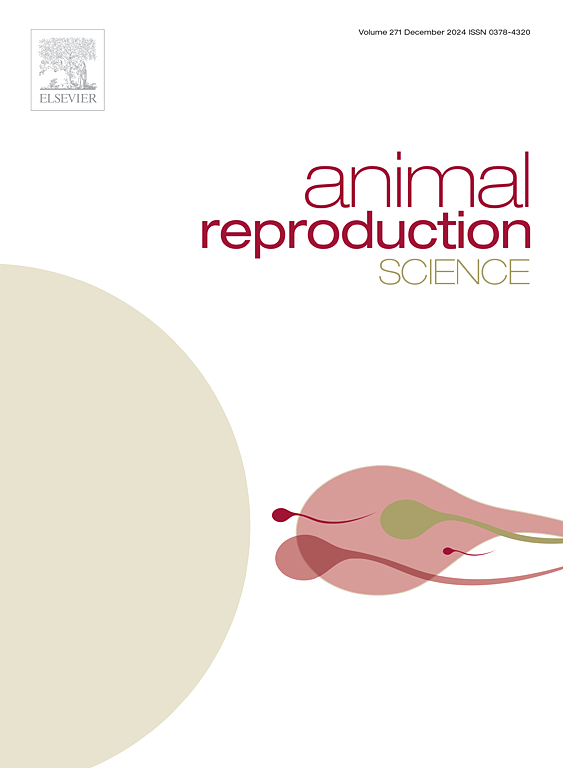慢速冷冻后犬腔前卵泡体外培养
IF 2.2
2区 农林科学
Q1 AGRICULTURE, DAIRY & ANIMAL SCIENCE
引用次数: 0
摘要
本研究的目的是分析慢速冷冻对犬离体腔前卵泡形态和活力的影响。收集不同年龄的卵巢子宫切除母狗的卵巢。采用胶原酶消化液从卵巢皮层分离卵泡,随机分为新鲜对照组和慢速冷冻组。新鲜和冷冻/解冻的腔前卵泡分别在100 µl培养液中培养,在38.5°C和6.5% % CO2条件下培养10天,更换一半培养基,于第2天、第5天和第10天收集培养基样品进行激素分析。检测解冻后活细胞率、正常形态率、面积变化、雌二醇和黄体酮产量。冷冻/解冻卵泡的活细胞数量低于新鲜卵泡(分别为94.69 %( ± 6.97)和98.58 %(± 1.71)[p <; 0.05])。正常形态率仅在第2天有差异(新鲜91.2 %,冷冻/解冻50 %,p <; 0.05),两组均呈下降趋势。在第5天和第10天发现了卵泡生长的差异,新鲜卵泡的面积低于冷冻/解冻的卵泡(分别为5.84 vs12.62 mm2 [p <; 0.005]和6.47 vs 10.75 mm2 [p <; 0.05])。在激素产生方面,冷冻/解冻样品中的雌二醇和孕酮浓度在整个培养期间低于新鲜卵泡样品。综上所述,我们的数据表明,慢速冷冻可以使犬卵泡存活,但会降低卵泡的质量和活力。本文章由计算机程序翻译,如有差异,请以英文原文为准。
In vitro culture of canine preantral follicles after slow freezing
The objective of this study was to analyse the effect of slow freezing on the morphology and viability of canine isolated preantral follicles. Ovaries were collected from ovariohysterectomy bitches being in different ages. Preantral follicles were isolated from ovarian cortex using collagenase-based digestive solution and randomly divided into two groups: fresh control and slow frozen. Fresh and frozen/thawed preantral follicles were cultured individually in 100 µl drops of culture medium for 10 days at 38.5 °C with 6.5 % CO2, and half of the medium was changed and samples from culture media were collected on Day 2, Day 5 and Day 10 for hormonal analysis. Post-thaw live cell rate, normal morphology rate, area change, and estradiol and progesterone production were examined. Frozen/thawed follicles have lower number of live cells than that of fresh ones (94.69 % ( ± 6.97) vs 98.58 % (± 1.71), respectively [p < 0.05]). Normal morphology rate was different only on Day2 (91.2 % in fresh and 50 % in frozen/thawed, p < 0.05) and showed decreasing tendency in both groups. Differences in follicular growth were found on Day5 and 10, when fresh follicles showed lower area than that of frozen/thawed ones (5.84 vs12.62 mm2 [p < 0.005] and 6.47 vs 10.75 mm2 [p < 0.05], respectively). Regarding the hormonal production, estradiol and progesterone concentrations were lower in frozen/thawed samples than that of fresh follicles throughout the culture period. In conclusion, our data suggest that slow freezing can provide canine follicular survival, however, the quality and viability of the follicles are reduced.
求助全文
通过发布文献求助,成功后即可免费获取论文全文。
去求助
来源期刊

Animal Reproduction Science
农林科学-奶制品与动物科学
CiteScore
4.50
自引率
9.10%
发文量
136
审稿时长
54 days
期刊介绍:
Animal Reproduction Science publishes results from studies relating to reproduction and fertility in animals. This includes both fundamental research and applied studies, including management practices that increase our understanding of the biology and manipulation of reproduction. Manuscripts should go into depth in the mechanisms involved in the research reported, rather than a give a mere description of findings. The focus is on animals that are useful to humans including food- and fibre-producing; companion/recreational; captive; and endangered species including zoo animals, but excluding laboratory animals unless the results of the study provide new information that impacts the basic understanding of the biology or manipulation of reproduction.
The journal''s scope includes the study of reproductive physiology and endocrinology, reproductive cycles, natural and artificial control of reproduction, preservation and use of gametes and embryos, pregnancy and parturition, infertility and sterility, diagnostic and therapeutic techniques.
The Editorial Board of Animal Reproduction Science has decided not to publish papers in which there is an exclusive examination of the in vitro development of oocytes and embryos; however, there will be consideration of papers that include in vitro studies where the source of the oocytes and/or development of the embryos beyond the blastocyst stage is part of the experimental design.
 求助内容:
求助内容: 应助结果提醒方式:
应助结果提醒方式:


